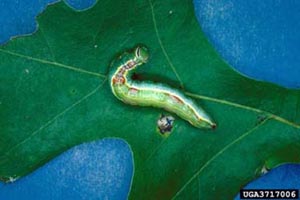DACF Home → Bureaus & Programs → Maine Forest Service → Forest Health & Monitoring → Forest Pest Index → Variable Oakleaf Caterpillar
VARIABLE OAKLEAF CATERPILLAR
Lochmaeus (Heterocampa) manteo (Doubleday)
This native species occurs in deciduous forests throughout much of eastern North America. Although outbreaks have not been uncommon throughout much of its range, only two outbreaks have been recorded in Maine. The first of these occurred around 1956 when roughly 23,500 acres of northern hardwoods were defoliated in north central Maine. The second outbreak began in roughly the same area in 1986 and expanded to include northern hardwood stands across much of central and eastern Maine. At its peak in 1988, roughly 120,000 acres were defoliated. By 1991 populations had subsided to nearly endemic levels. A surprisingly strong population resurgence, however, began in early August of 1994 and moderate to heavy defoliation soon became evident especially on beech in eastern Maine.
Outbreaks of this defoliator normally consist of a complex rather than single species. Over 25 different insects were recorded in noticeable numbers from infested stands during the outbreak period from 1988 through 1991. Two species, the variable oakleaf caterpillar and the orangehumped mapleworm, usually make up the major destructive component on beech and sugar maple aided by the birch sawfly on white and gray birch. In any infestation the ratio of one species to another may change for one reason or another.
Hosts
The variable oakleaf caterpillar can be found on a wide variety of deciduous hosts with oak being preferred throughout most of its range. Of the oaks, white seems to be preferred and it may be due to the lack of white oak in Maine, that a secondary host, beech, seems to be preferred here. Basswood and to a lesser extent birches may also serve as food.
Description and Life Cycle
Moths of this species have a wingspan of 1.5 to 1.8", are ash grey in color and have few distinctive markings which can be used to readily separate them from many similar species found in Maine. Moths of the variable oakleaf caterpillar are active in Maine from late June through mid August with the peak of activity in July. The females lay tiny light greenish, spherical eggs in single or multi-layered irregular clusters of 50 or more on the underside of host foliage in July. Hatching takes place in one to two weeks. Just prior to hatching eggs appear spotted with reddish-purple. Black eggs are usually parasitized.

Photo: Lacy L. Hyche, Auburn University, Bugwood.org
The tiny spotted larvae of the variable oakleaf caterpillar at first feed gregariously on the lower leaf surface near the expended egg shells. They usually skeletonize portions of one to three leaves in a cluster. The presence and frequency of these clusters of tissue-paper thin skeletonized leaves on beech in early August is an early indicator of the degree of defoliation which can be expected. As the larvae grow, they change their color pattern several times and may exhibit many individual variations. They also separate after the first molt and begin to feed singly. From this point on they cease to skeletonize and consume entire portions of the leaf. They pass through five instars prior to dropping to the soil to pupate. At maturity the color is generally green but a fairly high percentage of individuals may be deep pink or reddish. Mature larvae are roughly 1.5" long with a distinctive dorsal band which is often dark red in color. The head is most often green with two darker vertical lines which are usually black, edged with creamy white. There is also a definite yellowish lateral line along each side of the larva at or below the spiracles (breathing pores) which separates this species from other prominents (Heterocampa).
Mature larvae drop to the soil when done feeding, usually in late August or September. They burrow into the soil beneath the leaf litter and form a loose silk lined cell. Here they become inactive larvae (pre-pupae) and remain in this state throughout the winter.
Pupation of this species usually takes place in the soil cell in late May or June of the next year. Some individuals, however, remain prepupae throughout the entire following season and pupate in May or June of the second spring following defoliation. Pupae of the variable oakleaf caterpillar are about .75" long, light chestnut brown, smooth and shiny.
Control*
Normally populations of these late season defoliators drop out after two or three years in any one area without serious impact. Chemical control is neither necessary nor recommended in forest stands and the most significant damage occurs where a stand is opened up due to heavy defoliation. In this case heat and/or drought can cause serious root damage resulting in dieback or mortality of severely stressed trees.
*NOTE: These recommendations are not a substitute for pesticide labelling. Read the label before applying any pesticide. Pesticide recommendations are contingent on continued EPA and Maine Board of Pesticides Control registration and are subject to change.
Caution: For your own protection and that of the environment, apply the pesticide only in strict accordance with label directions and precautions.
MAINE DEPARTMENT OF AGRICULTURE, CONSERVATION AND FORESTRY
Maine Forest Service - Forest Health and Monitoring Division
April 2000